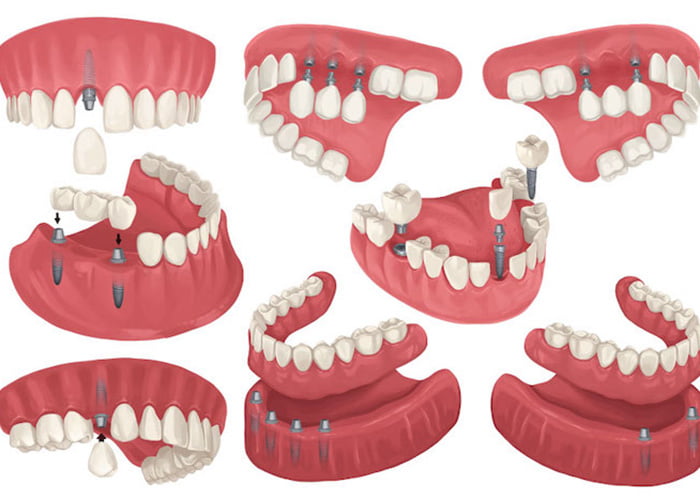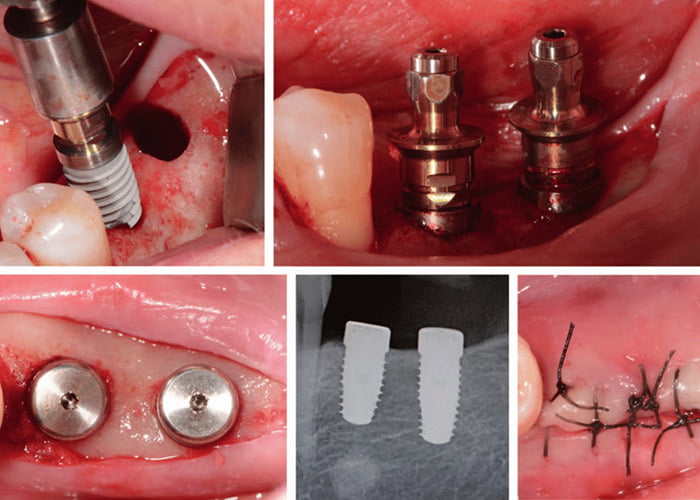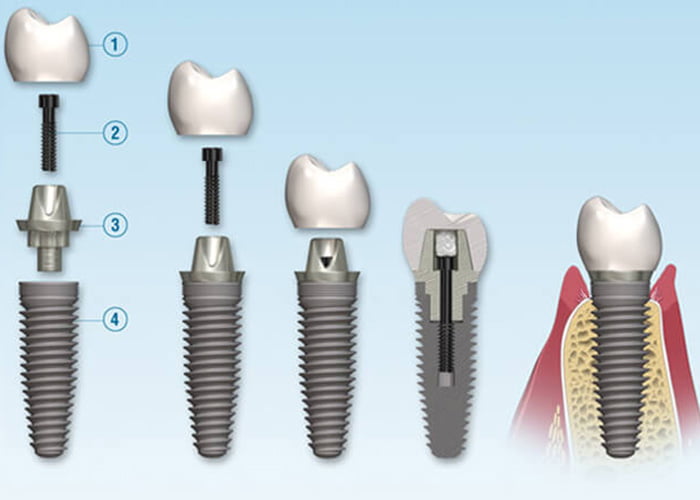Missing teeth can cause your bite to become out of balance, changing the way your face is shaped. They might also cause you to doubt your grin. Your dentist can suggest artificial teeth that are linked to or close to the jawbone using a dental implant if you decide to replace lost teeth. Dental implants are prosthetic tooth roots that are inserted into the jawbone surgically.
The implant is held firmly in place for several months by the bone surrounding it, which develops. The gap is then filled in with prosthetic teeth that are connected to the implant using a metal connector.
Dental implant surgery involves replacing tooth roots with metal, screw-like posts, and missing or damaged teeth. Read this article to learn more about dental implant procedures and dental implant surgery.
Types of dental implants
You can pick between sub-periosteal and endosteal dental implants, which are the two most popular forms. The most frequent and safest approach is endosteal, which is followed by subperiosteal.
Endosteal (in the bone)
The most prevalent kind of dental implant is endosteal. The majority of patients can benefit from them, but they need a strong, healthy jawbone for the post to fuse to. They are designed like screws and serve as stand-in posts. They are inserted into the jaw, which is where the fake teeth are attached. After the surgery, the wound needs some time to heal. It needs time to come together and fortify itself. The false teeth can be attached to the post to blend in with the neighboring teeth once it has healed. The second-most popular implant may appeal to you more if you don’t like the notion of having anything inserted into your jawbone.
Subperiosteal (on the bone)
Subperiosteal Implants are another variety of dental implants. The primary substitute for endosteal implants is this. Subperiosteal implants lay on top of the jawbone but are still buried beneath the gums, as opposed to being fastened into the jawbone. Under the gum, a metal frame with a post attached to it is positioned. Following that, the gum heals around the frame, holding it in place. The poles that protrude from the gum are used to hold the fake teeth in place. This method is only done when the patient’s jawbone is insufficient for implant placement or when the patient simply does not want to undergo extensive oral surgery to add bone to the area.

Dental Implants Procedure
An artificial root is used to replace the natural one during the dental implant procedure. The jaw can be surgically prepared to accommodate a dental implant, which is a titanium fixture fashioned to imitate the roots of your teeth. The implant provides strength and attractiveness to address oral problems including missing or broken teeth. Also, compared to conventional solutions like dentures and crowns, dental implants stimulate bone formation, which prevents bone mass behind the gums from diminishing.
Read more: How much does Dental implant full mouth cost
Preparation
Dental implants may need a lengthy and difficult procedure, but the wait is worthwhile. Finding a dentist with experience in this surgical dental implant procedure is the first step in the process. Once you have located a reputable dentist, they will evaluate your mouth and inform you of what has to be done to prepare for the placement of the implants. At the initial appointment, the dentist will also review your medical history and develop your implant treatment plan.
The bone, nerves, and sinuses must all be thoroughly examined. To ascertain whether any underlying issues like tooth decay and gum disease could complicate the implant procedure for you, a panoramic x-ray will also be taken.
When there is a need to extract a decayed tooth, your dentist might recommend waiting for one or two months before moving on to the implant placement. However, if the situation is dire, it can be possible to extract a tooth and install an implant on the same day. Moreover, for patients with a weak or damaged jawbone, a dental bone graft or sinus lift could strengthen it.
Placing the Implant
In the dentist’s office, a local anesthetic is used for this dental procedure. Those who are concerned about the procedure can be given a sedative to help the process go more easily. Your dentist will advise you based on the number of implants that will be placed in your mouth and the difficulty of doing this surgery.
The oral surgeon first makes a slit in the gum to expose the bone before drilling a hole for the titanium screw. The metal post is then screwed into position once that is finished. To prevent food from getting stuck in the gum after the implant has been put in, the gum tissue will then be sutured to cover the implant. It would take four to six months for the wound to heal. At this point, a procedure known as osseointegration causes the implant to gradually bond with the bone. The dentist must complete training because this technique is delicate. As a result, they can put implants precisely for optimum results.
Installing the Abutment
The abutment is put in place once the implant has merged completely. It joins the implant to the replacement tooth or implant crown. The placement of the abutment requires only little gum-opening surgery. The only anesthesia required is local, and it is an outpatient operation. The gum tissue will be wrapped around the abutment once it is in place, without covering it.
So far, there are some situations in which the implant and abutment are both installed at the same surgery. As long as the patient receives adequate time for the gums to recover, long-term unfavorable symptoms are typically not noticed in the person receiving treatment. You can be given a temporary crown for your teeth by your dentist. They heal concurrently to prevent the discomfort caused by the metal post poking through the gums. Moreover, the healing process takes about two weeks. As the porcelain crown will be fitted next, it would be the last stage of oral surgery.
See more: Is dental implant painful
Fitting the Crown
Your dental specialist will design the replacement tooth to fit your existing tooth structure after taking new dental impressions. You will make an appointment with your dentist once the swelling in your mouth has subsided to get the new crown. In order to manufacture the false tooth that would place on the abutment, they must first take impressions of your mouth.
Recovering from The Surgery
After the dental implant procedure, It will take some time for you to recuperate fully, and you might experience some minor discomfort and pain. Gum swelling, soreness near the implant post, gum bruising, and very little bleeding are all possible side effects. Your symptoms need to be subsiding day by day and not last longer than necessary. Contact your dentist right away if the symptoms worsen so they can offer you some painkillers. To hasten your recovery, follow the post-operative recommendations consistently. You might need to go to the dentist’s office more frequently so that your dentist can assess your progress. You can resume your normal eating habits once the implant placement and recuperation process is over. The strength of implant teeth is equal to that of natural teeth.
How Long Does a Dental Implant Procedure Take?
Your dentist will arrange your operation after the entire examination is complete. The actual first stage in the implant process is the operation. The titanium implant will be inserted into your jawbone just below the gum line by your dentist. The placement of each implant during this procedure typically takes 1-2 hours. Most dentists will wait around 3 months after this stage is finished before performing the final restoration of the tooth replacement. Although it may be annoying, the healing process is crucial to the success of dental implant treatment. To ensure that the implant is strong enough to support your final restoration, you must give it time to integrate into the bone.

Benefits of Dental Implants
For those who wish to replace a missing tooth, there is a dental implant procedure. They can be used to fill spaces left by a variety of conditions, including tooth decay or damage.
- Compared to other tooth replacement options, implants are stronger. When properly maintained, these also last for 15 to 20 years.
- One of the various choices for replacing missing teeth is an implant. They have the advantage of requiring less maintenance than alternatives like complete dentures. Nonetheless, for optimum performance, modifications might need to be made on a regular basis. Overall, however, you won’t experience any issues with these implants staying put.
- The teeth next to dental bridges are frequently harmed by them. A dental implant is a better choice because it will protect the natural teeth that are close by.
- For the purpose of preserving facial and bone structure as well as oral health, dental implants may be a helpful preventive treatment.
- Many people who wear removable dentures find that speaking becomes difficult due to the possibility that their teeth may slip and detach. Those who have dental implants can speak properly without being concerned about their teeth falling out, giving them a voice with a better range.
- The best approach to boost your confidence and give you a gorgeous smile is with dental implants. They appear prettier and are also more durable than conventional dentures.
Risk of Dental Implants
Despite the advantages, dental implants could nevertheless be risky.
- Infection: After surgery, it’s important to care for the implant. Maintaining good dental hygiene is important; failing to do so might result in unneeded discomfort and consequences.
- Insufficient osseointegration: A dental implant must fuse with the bone after being inserted in your mouth for it to work. If this does not occur, you might need to have a second implanted when the wound has healed.
- Dental implants that are too close to a nerve could cause long-term harm to that area of your mouth. Permanent numbness or discomfort in the mouth can result from harm to the blood vessels or other parts of the mouth’s structure.
- Implant fracture: Although implants are made to replace natural teeth, excessive stress might cause them to deteriorate more quickly. They must be taken out after the break because of these stresses, and new ones will be installed after a few months.
Conclusion
Please contact us via the website Dentistry near Marysville as soon as possible to schedule an appointment if you need a dental implant. You are always welcome here, so feel free to ask us any questions; we would be more than pleased to answer them.



